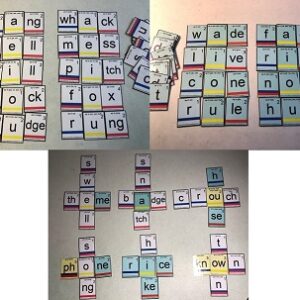12 extra decks of phonics playing cards
$AUD13.33
Download and print 12 decks of our child-sized (5 X 6.5cm) playing cards for fun reading practice. These decks fill some gaps in our previous decks – compound words, “soft” C and G, additional spellings of “short” vowel sounds – and then present additional consonant sounds with multiple spellings. Words face both up and down, for easy reading from either side of a table.
Description
Download and print 12 decks of our child-sized (5 X 6.5cm) extended code playing cards, for fun reading practice involving plenty of repetition-to-mastery. Words are printed facing both directions, so they are easily read from either side of a table.
These decks focus on the following:
- Compound words with “short” vowels like “backpack”, “chestnut”, “drumstick”, “eggshell”, “grandstand”, “himself”, “lipstick”, “mothball”, “quicksand”, “stronghold” and “uphill”.
- The letter C pronounced /s/, as in “cement”, “ice”, “place”, “pencil”, “produce”, “civil”, “race” and “recent”.
- The letter G pronounced /j/, as in “age”, “danger”, “giant”, “huge”, “refugee”, “surgical”, “tragic” and “vigil”.
- The sound /e/ spelt E as in “bed”, EA as in “bread”, AI as in “again”, A as in “any”, U as in “bury”, EI as in “leisure”, IE as in “friend”, and EO as in “leopard”.
- The sound /i/ spelt I as in “did”, Y as in “myth”, E as in “English”, U as in “busy”, O as in “women” and IE as in “sieve”.
- The “short” sound /oo/ spelt OO as in “cook”, U as in “full”, OUL as in “would” and O as in “woman”.
- The sound /m/ spelt MM as in “common”, MB as in “climb”, MN as in “solemn”, ME as in “come” and GM as in “phlegm”.
- The sound /n/ spelt NN as in “tunnel”, KN as in “know”, GN as in “gnome”, NE as in “caffeine”, NNE as in “julienne”, PN as in “pneumatic” and MN as in “mnemonic”.
- The sound /t/ spelt TT as in “tattoo”, TE as in “torte”, TTE as in “statuette”, BT as in “subtle”, TH as in “Thailand”, PT as in “receipt” and CHT as in “yacht”.
- The sound /k/ spelt CC as in “broccoli”, CH as in “scheme”, QU as in “quiche”, QUE as in “opaque”, CQU as in “acquit”, CCH as in “zucchini” and KH as in “khaki”.
- The sound /g/ spelt GG as in “juggle”, GU as in “guy”, GH as in “ghetto”, GUE as in “synagogue”, and GE as in “renege”.
- The sound /r/ spelt RR as in “mirror”, WR as in in “wrong”, RH as in “rhubarb” and RRH as in “diarrhoea”.
These card decks can be used as part of most phonics/morphology-based reading/spelling teaching sequences. They can be sent home instead of a spelling list, with the expectation that students will learn to both read and spell the words accurately, and with a random sample of the words on an upcoming spelling quiz.
We suggest printing the cards on A4 200gsm cardboard, and if you plan to use them a lot, laminate them. We highly recommend that children practise their scissor skills by cutting them up, rounding the corners if a more professional look is sought.
The cards can be used to play any card game requiring a typical deck of playing cards, but players must read the cards’ words as they play them. We’ve made some videos of example games to get you started:
- California Speed
- Spit
- Snip Snap Snorum
- War
- Beggar Thy Neighbour
- Slapjack
- Snap
- Mancala, for which you’ll also need to download our Mancala board.
If you’re looking for more/different games, do an internet search for “kids’ playing card games”, and you’ll find plenty, including lots of videos showing how to play. Enjoy!




